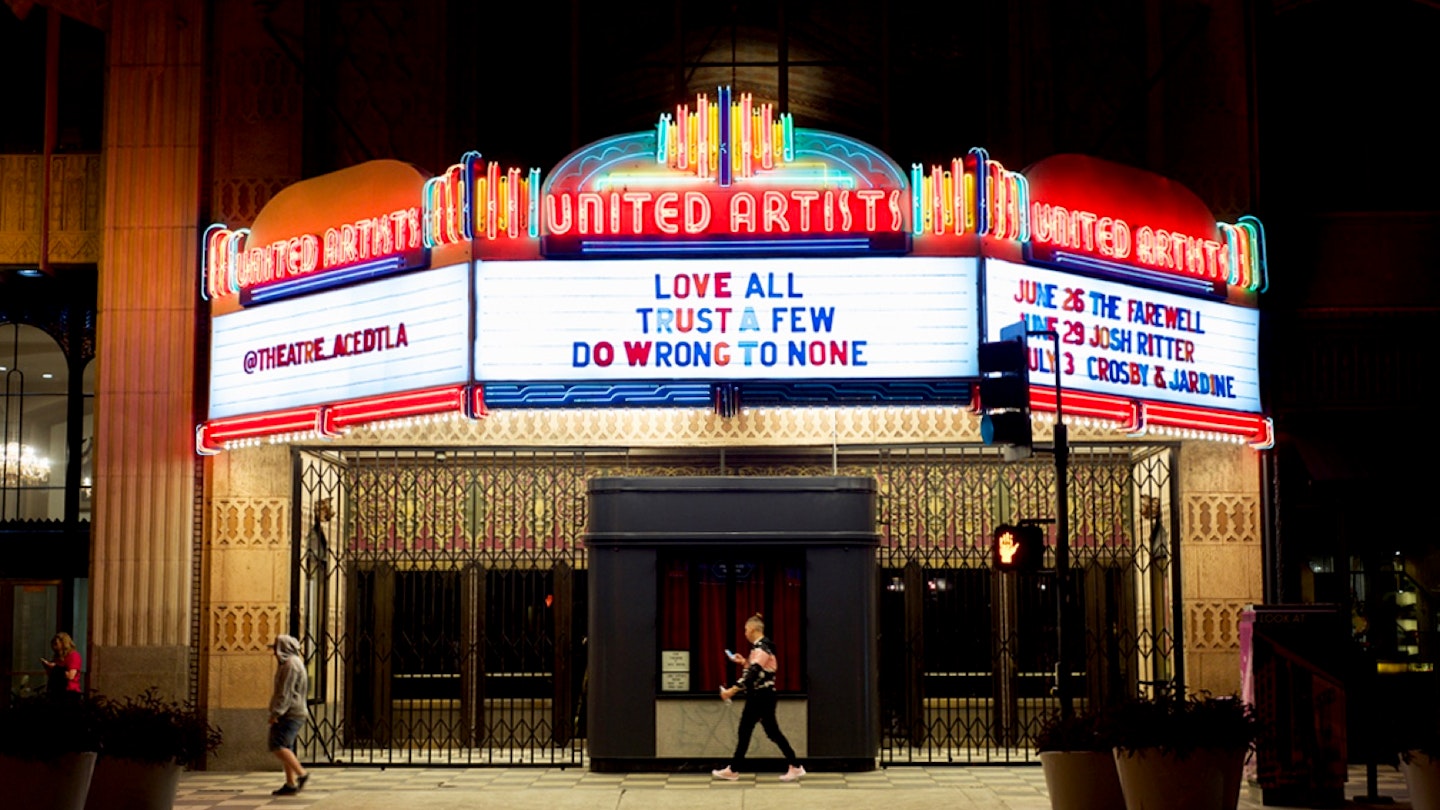Saving LA’s Neon
During World War II, the city’s neon signs were extinguished due to fears of a Japanese attack, and most were never turned back on. However, 25 years ago, Havana-born Adolfo Nodal, then working in LA’s cultural affairs department, decided to change that. He undertook the monumental task of reviving Los Angeles neon signs after over half a century of darkness.
Nodal began with the iconic rooftop signs designed for visibility to drivers on newly established freeways, primarily advertising hotels and apartment buildings.
“On the rooftops, the total reinforcement of the scaffold structure was the first step,” Nodal explains. “Thankfully, they were all very well built from the late 1920s to the early 1940s by migrating steel workers from the east coast.”
The restoration involved intricate processes including stripping and fully repairing all channel letters and metal design elements, complete electrical fittings, and installing new wiring from the sign to the main source. Additionally, all new neon glass, gas, and electrodes were added. A high-quality transformer was also necessary to ensure they shine brightly once again.
That was merely the beginning. From the Wilshire Corridor to Hollywood’s historic cinemas and the fantastical theater of Downtown LA, Adolfo and his team, known collectively as Lumens, restored 185 signs over 25 years.
Bright Lights on Broadway
Tour guide Stuart Wood has become an expert on the vibrant results he encounters on his nightly bar tours—a fast-talking, entertaining exploration around Art Deco architecture, legendary movie spots, mob sites, and, undoubtedly, neon signs. The tour features a memorable stop for selfies beneath the beautiful neon portico of the United Artists Building, constructed by Hollywood legends Mary Pickford, Douglas Fairbanks Senior, D.W. Griffith, and Charlie Chaplin, now restored as the Ace Hotel.
At the Freehand Hotel, which boasts the tallest neon sign in the city, Wood explains how gangsters fled LA to settle in Las Vegas, taking with them the neon aesthetic that had once defined Downtown.
“Downtown LA’s vintage neon serves as a reminder that before Vegas, this place was Sin City,” he states. “What was viewed as vice in LA during the 1930s and 40s transitioned into entertainment in Vegas in the subsequent decades. The revival of these lights symbolizes the resurgence of one of LA’s most dynamic areas that had long been forgotten.”
Lighting Up the Valley
Nevertheless, the neon revival is not confined to Downtown. In the San Fernando Valley, just north of the city, two airport hangars house the Valley Relics Museum, a captivating personal collection featuring an animated neon mustang in perpetual gallop, alongside other salvaged signage.
Just a few blocks away, Los Angeles neon artist Michael Flechtner operates his workshop, where a suspended neon dolphin appears to swim through air, accompanied by sketches, wires, gadgets, and stacks of unshaped glass tubes waiting to be transformed.
Flechtner demonstrates the artistry of creating neon; heating slender tubes to twist them into shape, then attaching electrodes and inserting a mercury bubble that, mixed with argon gas, produces a striking blue light. After sterilizing the glass, he creates a vacuum and introduces gas into the tube, resulting in a stunning flash that fills it with vibrant light and life.
Part scientist and part craftsman, Flechtner unequivocally affirms that neon is indeed a captivating art form.
Museum of Neon Art and the Neon Cruise
This artistic form is brilliantly showcased at the Museum of Neon Art located in the satellite city of Glendale. Visitors can marvel at contemporary works—some delicately entwined in tubing and others embedded into driftwood—displayed alongside vintage signage saved by the museum. Among the highlights is an impressive 37-foot dragon that once adorned Grauman’s Chinese Theater, now restored, reclaiming its rightful place among the city’s treasures.
Every Saturday night, the museum hosts a Neon Cruise, led by author and preservation consultant Eric Lynxwiler aboard a double-decker open-top bus. As the bus navigates through the LA night, Lynxwiler narrates a captivating three-hour journey filled with stories, history, architecture, and humor—often highlighting the changes in Downtown.
This experience is not only entertaining but also rich in information. Riders learn about the neon pagodas of Chinatown and the tale of a long-lost neon light found deep within Clifton’s Cafeteria, still glowing after 85 years. A stop at the modern neon wall at Grand Central Market and a scenic drive through Hollywood as the twilight sets in further enhance the experience.
Los Angeles Neon: Light Come Alive
In unison with the current fascination surrounding neon, Eric is captivated in an incandescent love affair with these glowing masterpieces. While neon represents a classic icon of modernity, it simultaneously stands as the antithesis of mass production—each letter on each sign meticulously handcrafted. Thus, the neon lights serve as a tangible link to Los Angeles’ artisan roots.
Moreover, it is the vibrant visual and spiritual energy of neon that fundamentally captivates. Michael Flechtner poetically describes neon as “fire inside a tube.” It is nearly impossible to resist the primal attraction to flames; and when that flame is suspended in the sky—framed by curlicues of glass, set against a picturesque sunset enlivened by a chorus of palm trees—the allure becomes undeniable.
Helena Smith explored the wonders of Los Angeles neon thanks to LA Tourism.





